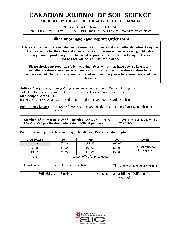摘要
Jiang, X., Wang, E., Chen, X., Xia, X. and Shi, C. 2012. Field study on macropore flow in typical Black soils of northeast China. Can. J. Soil Sci. 92: 559-566. Macropores are important preferential pathways for the transport of water and contaminants in soil. A series of hood infiltration experiments were conducted using dye tracers (Brilliant Blue FCF) at pressure heads of -5.0 cm, -3.0 cm, and -1.0 cm at a conventional tilled site on Keshan Farm, northeast China. The study objective was to combine the test method of dye tracing with a hood infiltrometer to analyze soil subjected to conventional tillage methods. Dye staining patterns and macroporous networks were analyzed by excavation, mapping, photography, and image analysis. Results showed that macropore flow began very near the soil surface under three pressures heads of -5.0 cm, -3.0 cm and -1.0 cm, and that a pressure head of -1.0 cm resulted in more lateral flow. Soil deeper than 40.0 cm was less disturbed, which resulted in good continuity. At pressure heads of -5.0, -3.0 and -1.0 cm, the dye staining technique resulted in maximum stained depths of 74.3, 60.7 and 64.7 cm, respectively, with maximum stained widths of 41.6, 41.5 and 47.9 cm, respectively (at depths from 14.0 to 28.0 cm). Soil under a pressure head of -1.0 cm had the highest initial and steady infiltration rates of 13.0 and 4.1 mm min(-1), respectively. Soil under a pressure head of -5.0 cm showed the most connectivity. To distinguish the macropores from the interaction area of macropore flow and the soil matrix surrounding the macropores, the stained area was separated into different classes based on dye color.
- 出版日期2012-3
- 单位东北林业大学
